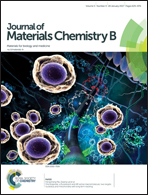Imaging of carotid artery inflammatory plaques with superparamagnetic nanoparticles and an external magnet collar†
Abstract
Stroke is one of the top three fatal diseases in human history. Inflammatory injury of the artery endo-membrane system is widely accepted as the major starting mechanism for the formation and enlargement of atherosclerosis plaque, which can be diagnosed by B-ultrasound or carotid angiography. However, clinical data reveal that there are asymptomatic patients that are not diagnosed until the stenosis degree is over 70%. Superparamagnetic iron oxide (SPIO), a promising candidate for a next generation contrast agent in medical imaging, has been used in the imaging of carotid artery plaques, but it still faces the challenge of targeted enrichment. Herein, we introduce a mature magnetic nanoparticle contrast agent and a promising method for diagnosing carotid artery inflammatory plaques with a Magnetic Resonance Imaging (MRI) technique. The superparamagnetic nanoparticles (SNPs) were synthesized by directly coating hydrophilic and high-magnetism Fe3O4 nanoparticles with an organosilica layer, which was followed by modification with polyethylene glycol. It was verified that the resultant nanocomposite possesses a higher structural stability, excellent dispersivity, separability, as well as biosafety. More importantly, the strong magnetism was preserved, making it possible to attract the SNPs with an external magnetic field and achieve a target concentration within the lesion. Moreover, an in vitro magnetic collar, designed to produce a stable magnetic field around the superficial common carotid arteries was introduced. The SNPs particles in the blood flow were slowed down by the collar, their motion direction was changed, and they were captured by the inflammatory cells in the plaque. The effectiveness and feasibility of the particles were evaluated via testing the MRI performance on histological levels with a rat carotid plaque model. The SNPs that were concentrated and accumulated in the plaque were verified to present an evident, negative enhancement in the Proton Density-T2 (PD-T2) sequence images. Therefore, it was demonstrated that the superparamagnetic nanoparticles have great potential as an MRI contrast agent to detect early stage carotid artery inflammatory plaques with an external magnetic collar.



 Please wait while we load your content...
Please wait while we load your content...